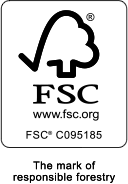Natural materials create green buildings
Wood has a minimal environmental impact
Wood is a natural product, very durable and will last for years. Industrial wood processing has very limited environmental impact and wood itself stores CO2. Wood is not only entirely biodegradable but also recyclable. As a raw material it is completely renewable and can be acquired from managed forests (with a FSC® or PEFC certificate).
Metal parts are also recyclable
Also the Derako metal system parts, like the carriers, clips and profiles, can be easily separated at the end of the user cycle and recycled.
 Derako is Cradle to Cradle® certified
Derako is Cradle to Cradle® certified
Working according to and acting upon Cradle to Cradle® contributes to the environmental friendliness of the product. During the design process not only the present needs are looked at but also the possibilities for future generations. Improvements are constantly being worked on in the areas of material health, material recycling, renewable energy and carbon management, water management and social justice.
Environmentally friendly finishes for wood and systems
 Derako wants to be sure that all products and systems have a lasting positive influence on human health and the environment. A lot of thought is given to the materials used and their finishes. For example the DerakoO varnish finish is environmentally friendly and the Derako solid wood system has a very low emission (A+ certified). Also, in production Derako are using more and more renewable energy sources, and with (among others) an FSC and PEFC certification attention is paid to the responsible management of raw material resources.
Derako wants to be sure that all products and systems have a lasting positive influence on human health and the environment. A lot of thought is given to the materials used and their finishes. For example the DerakoO varnish finish is environmentally friendly and the Derako solid wood system has a very low emission (A+ certified). Also, in production Derako are using more and more renewable energy sources, and with (among others) an FSC and PEFC certification attention is paid to the responsible management of raw material resources.
Environment management system according to ISO 14001
Derako is an ISO 14001 certified organisation and this means that an extensive environment management system (EMS) has been implemented within the organisation. Within the methodology of an environment management system, the structural monitoring of emissions, waste, used raw materials, energy and other environmental aspects offers a good insight into the organisation's environmental performance. In this way the environmental objectives and the achieved results can be made comprehensible.
